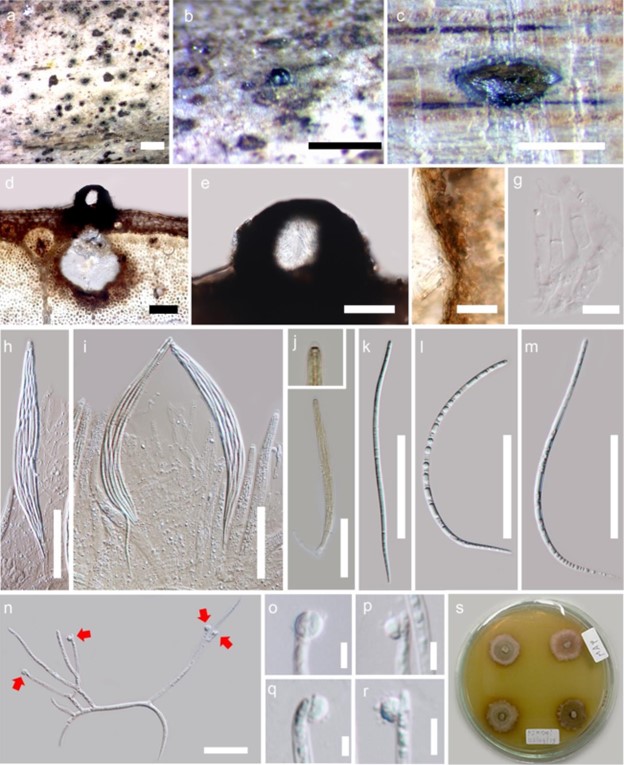Neolinocarpon rachidis Konta & K.D. Hyde,
Index Fungorum number: IF 553962; Facesoffungi number: FoF 03846
Etymology – The specific epithet refers to the host habitat (rachids)
Holotype – MFLU: 15–0307
Saprobic on rachis of Arenga pinnata (Wurmb) Merr. Sexual morph Ascomata 508–590 μm high × 320–390 μm diameter ( x = 557 × 346 μm, n = 10), solitary, deeply immersed, with a central raised, black, globose-subglobose papilla, with a central ostiole. Papilla 157–223 μm high × 127–198 μm diameter at the base (x̅ = 188 × 157 μm, n = 5), black, shiny, with hyaline periphyses. Peridium 34–80 μm wide (x̅ = 55 μm, n = 10), outer cells merging with the host epidermal cells, composed of dark brown to black cells of textura angularis. Hamathecium comprising numerous, 2.5–4 μm diameter (x̅ = 3 μm, n = 10), hypha-like, septate, unbranched, paraphyses, longer than asci. Asci 157–205 × 9–19 μm (x̅ = 180 × 14 μm, n = 20), 8-spored, unitunicate, cylindrical, long pedicellate, with a wedge-shaped, J-, subapical ring. Ascospores 123–140 × 2–4 μm (x̅ = 133 × 3 μm, n = 20), parallel in the ascus, becoming spiral when mature, filiform, straight or curved, hyaline, aseptate, containing numerous refringent septum-like bands, rounded at the apex with an appendage, pointed at the base, smooth-walled. Asexual morph Undetermined.
Culture characters – Ascospores germinating on MEA within 7 days. Colonies on MEA reaching 3–4 cm diameter after two months at 25°C, white at the edge, brown in the middle with strong radiations outwards. After 30 days of incubation, colonies smooth, flat, margin undulate, white to gray in the center, gray-brown at the margin, mycelium becoming dark brown when growing into media, hyphae septate, branched, smooth-walled.
Material examined – THAILAND, Phang-Nga Province, on dead rachis of Arenga pinnata (Wurmb) Merr. (Arecaceae), 5 December 2014, Sirinapa Konta, PHR06e (MFLU 15–0307, holotype); HKAS 100702, isotype; ex-type living culture, MFLUCC 15–0332).
GenBank Accession numbers – SSU: MG366598
Notes – Neolinocarpon rachidis is typical of Neolinocarpon species in having deeply immersed ascomata with a shiny visible papilla and filiform, hyaline ascospores. However, it is distinct as ascospores are rounded at the apex and pointed at the base, and differing types of mucilaginous appendages (Table 1). In the phylogenetic analysis, N. rachidis clusters with N. arengae (96% ML, 1.00 PP) (Fig. 1), but the species have very different ascospores.

Figure 1. Neolinocarpon rachidis (Material examined – THAILAND, Prachaupkhirikhan Province, on dead of petiole, Cocos nucifera (Arecaceae) , 30 July 2015, Sirinapa Konta PJK04i, MFLU 15–2347). a Appearance of ascomata on host substrate. b Close up of ascomata. c Yellowish ascospore mass. d Section of ascoma. e Papilla. f Peridium. g Paraphyses. h-i Asci. j J-, a reaction of apical ring. k-m Ascospores. n Germinated ascospore (appressoria at red arrow). o-r Appressoria. s Culture on MEA. Scale bars: a = 1000 μm, b, c = 500 μm, d = 100 μm, e, h-n = 50 μm, f = 20 μm, g = 10 μm, o-r = 5 μm.
